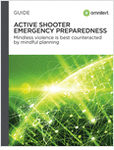 | Violence has always been a threat to human life, but the rise of mass shootings in America really began in the nineties with Columbine. After the tragedy at Virginia Tech in 2007, campus safety became top of mind for administrators, faculty, staff, parents, and students. These incidents are not just happening at colleges and schools; they are happening in all types of places of work, play, and worship. Over the last decade, there have been 475 people killed and 882 people wounded in America due to mass shootings. Legally, employers must now address the hazard of an aggressive intruder or active shooter who means to do harm to people in work settings. Although there is usually no way to know when these attacks are coming, or how to prevent them from happening altogether, all organizations can work to better ensure the safety of their employees, students, and visitors through proper preparation, response, and recovery. This is accomplished by developing a broader understanding of the stages of critical incidents and enabling modes of communication that help ensure a more successful outcome. It’s not enough to plan for a potential hazard or crisis; the ability to connect and engage with the impacted community during an incident is paramount. Only through reliable forms of communication can we quickly disperse the critical information that is needed to protect those in our care. This holistic perspective translates to a practical blueprint around which an entire organization can unite, and from which they can deliver a coordinated and well-orchestrated emergency response to an active shooter incident. The Critical Communications Cycle (CCC) is a blueprint that maps each phase of incident communications to the associated actions required for success in each. In other words, the CCC conveys what actions are needed before, during, and after a crisis. Request Free! |
